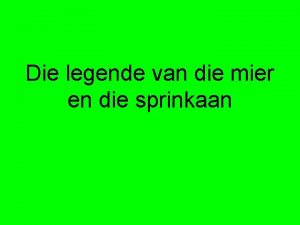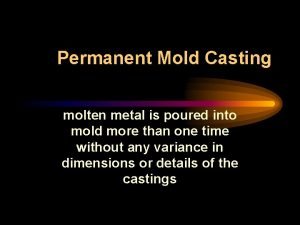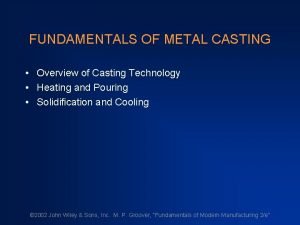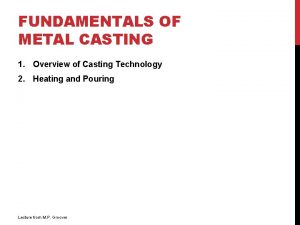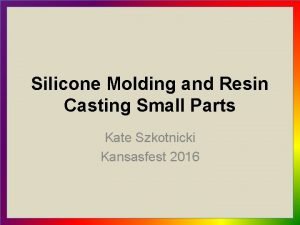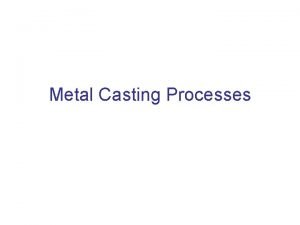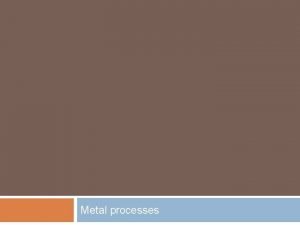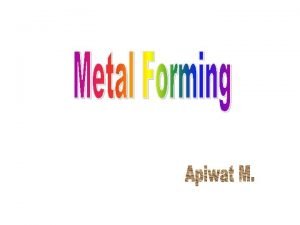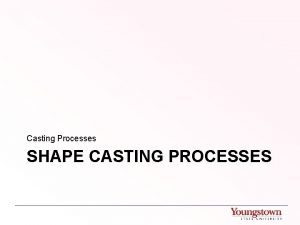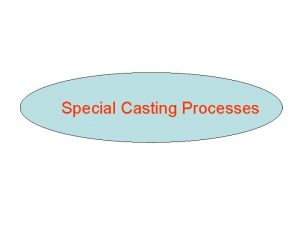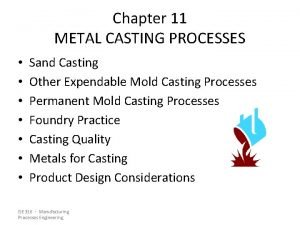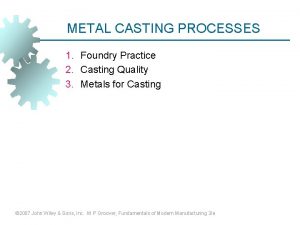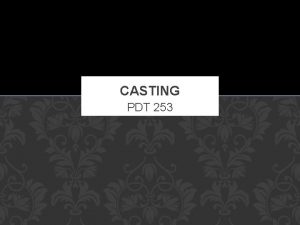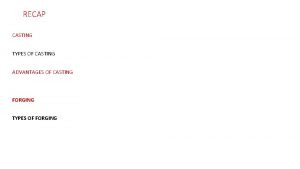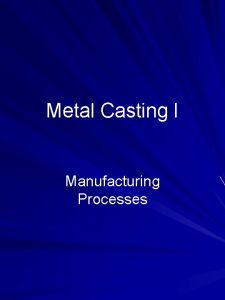Metal processes Die Casting Large quantities of quality












- Slides: 12

Metal processes

Die Casting Large quantities of quality castings are required in industry, the moulds(dies) need to be permanent. Alloy steel moulds are costly to produce because they are made in sections fro easy removal High operating costs involved make this process economically viable for high volume mass production where accuracy of shape, size and surface finish is essential. Materials used in this process include low melting temperature allows, lead, zinc, aluminium and brass alloys. Identifying features: Section hair lines, ejector pin marks, flashes caused by leakages left on internal surfaces, sprue and runner marks

Die Casting A measure of molten metal is poured into the charge chamber An injection piston then forces the metal into a water cooled die through a system of sprues and runners The metal solidifies rapidly and the casting is removed, complete with its sprues and runners.

Pressure Die Casting “hot” chamber and “cold” chamber processes are used Both processes have molten metal that is forced into a metal die by a hydraulic ram Thin sections and complex shapes with fine detail are possible.

Sand Casting Most frequently used metal casting process ‘Green’ found sand (describing damp quality that bonds sand together) is a blend of silica grains, clay and water. Oil-bound sand gives excellent results but is relatively expensive and difficult to reconstitute. Element of waste involved as sand that is in contact with hot metal will burn which need to be scraped out and disposed of. Quality of casting depends on quality of pattern that is normally made from wood. Pattern requires radiused corners, drafted sided and good surface finish. Material: Iron, aluminium and non ferrous alloys. Features: Complex 3 D components, Draft angles, rounded corners and strengthening webs.

Sand Casting Place pattern centrally in drag Pack sand around pattern Turn drag over and attach cope Insert sprue pins and pack sand around Remove sprue pins Split moulding box and cut gates Remove pattern to leave a cavity Reassemble cope so mould is ready to recieve molten metal Pour the molten metal into runner. Melt fills mould and exits, along with any gases,

Press Forming Involves squeezing sheet metal between two matched metal moulds (dies) Gives a very strong, shell like structure. One die is mirror image of the other apart from an allowance for the thickness of the material. Machining of these dies is a specialised skill. Can be complicated and difficult hence time consuming Very expensive to produce. Rubber blocks can be used instead of one of the dies making it more straightforward applicaitons. Material: sheet metals of various steels, aluminium alloys, brass and copper Features: Different operations can be identified of ribs, piercing

Press Forming A blank is cut to the required size The blank is placed in a press Product id formed using immense force. 1000 tones are required to manipulate 3. 5 mm thick steel plate

Piercing and blanking is essentially the same process. Involves the stamping of shapes out of sheet metal of metal strip Differences depend on which bit of metal is to be kept Piercing is when a shaped hole is made in the metal Blanking is when a shape is stamped out of metal then used. Material: most types of metals can be used. Metal is normally annealed to minimize risk of fracture or tearing. Features: sheared surface will show 2 distinct areas of deformation and fracture.

Piercing and blanking Piercing: the punch and die shown. Note how the punch firs into the die but does not enter it. Accurate alignment of the two is essential. Blanking: main components used in mass production are a punch, a die and a stripper plate. The plate prevents the metal “riding up” the die on its upward travel. The die is attached to the main press by means of a bolster plate. Punch is attached to a movable ram.

Drop forging Industrial process used in the production of high quality, strong metal components or products. Accurate to produce numerous objects by using a specialised shaped die to control flow of metal Highly skilled craftsman eliminated. Material: most metal in allow form, alloy steel and copper most common Features: flashes, die parting lines

Drop forging Hot metal billet placed between dies Metal forced into cavity using power driven hammer. Excess metal squeezed out forming a flashing around parting line of 2 dies. Once complete flash is removed using a trimming die.
 Linear acceleration vs tangential acceleration
Linear acceleration vs tangential acceleration Die sprinkaan en die mier
Die sprinkaan en die mier Graphite permanent mold casting
Graphite permanent mold casting Fundamentals of casting
Fundamentals of casting Fundamentals of metal casting
Fundamentals of metal casting Resin casting small metal parts
Resin casting small metal parts Chills in casting
Chills in casting Concurrent in os
Concurrent in os Gravity die casting advantages and disadvantages
Gravity die casting advantages and disadvantages Die casting punch
Die casting punch Die casting companies in china
Die casting companies in china Wholesale sheet metal forming
Wholesale sheet metal forming Suspended metal disk struck with a large mallet
Suspended metal disk struck with a large mallet

